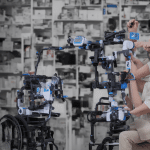As you navigate through your daily routines, you are constantly interacting with your environment and, consequently, subjected to various environmental exposures. Pollution and air quality, in particular, are hot-button issues that have garnered significant attention from the public and scientific community. With the advent of advanced wearable technology, monitoring these environmental factors has become increasingly attainable. Over time, a plethora of studies have emerged, exploring the relationship between personal exposure to pollutants and health outcomes. Today, we will delve into the latest advancements in wearable sensors for monitoring environmental exposure.
The Intersection of Health and Wearable Technology
In the realm of health and wellness, wearable technology has made quite a splash. These devices, often small and unobtrusive, offer a new frontier of health monitoring. They provide real-time data on a variety of health parameters, offering a more complete picture of a person’s health status than traditional methods.
A découvrir également : How Are AI-Powered Assistive Devices Transforming Lives of Individuals with Visual Impairments?
In recent years, researchers have begun to harness the power of wearables to study the impact of environmental factors on health. Sensors incorporated into these devices can monitor exposure to different environmental pollutants. This way, individuals can gain a personal understanding of their exposure to the environment, and researchers can gather large data sets on population-wide exposure levels.
The Evolution of Wearable Air Quality Sensors
Air quality is a critical aspect of the environment that directly affects human health. However, monitoring air quality at an individual level has been challenging due to the high cost and impracticality of traditional air monitoring systems.
Avez-vous vu cela : What Innovations Are Driving the Future of Clean and Renewable Energy Sources?
Enter wearable air quality sensors. These devices, often small enough to be worn on a wrist or clipped to clothing, can detect various pollutants in the environment. Over time, the technology behind these sensors has seen significant advancements. Early versions of these devices were costly and often lacked accuracy in measuring pollutant levels. However, newer models have become more affordable and accurate, thanks to advancements in sensor technology and data processing methods.
These wearables can detect a wide range of pollutants, including particulate matter, volatile organic compounds (VOCs), and harmful gases like nitrogen dioxide and ozone. They work by using various sensor types, such as electrochemical sensors for detecting gases and optical sensors for particulate matter. The resulting data can be synced to a smartphone app, allowing users to monitor their exposure levels in real-time.
Monitoring Personal Exposure to Chemical Pollutants
Beyond air quality, wearables have also been used to monitor exposure to specific chemical pollutants. These devices can provide valuable information about an individual’s exposure to harmful chemicals in their daily lives.
Recent studies have highlighted the use of wearable sensors for monitoring exposure to chemicals like pesticides, heavy metals, and even volatile organic compounds (VOCs) in consumer products. For example, a wearable device could detect the level of lead exposure in individuals living in areas with high lead pollution. By analyzing the data collected, researchers can understand the correlation between exposure to such pollutants and various health outcomes.
Environmental Data Collection and Analysis
One of the significant benefits of wearable technology for environmental monitoring is the ability to gather large amounts of data. This aspect not only allows individuals to monitor their personal exposure but also provides researchers with valuable insights into population-wide exposure levels.
The proliferation of wearables has led to the generation of vast amounts of data, often referred to as ‘big data.’ This data, when appropriately analyzed, can reveal patterns and trends in environmental exposure. It can also inform policy decisions on pollution control and environmental health.
Researchers can use this data to conduct longitudinal studies on the effects of environmental exposure on health. By continuously monitoring exposure levels over time, they can identify potential links between pollutants and health outcomes. This method stands in contrast to traditional environmental studies, which often rely on snapshots of exposure data or rely on estimates based on environmental monitoring stations.
The rise of wearable tech has undoubtedly revolutionized the way we monitor environmental exposure. As the technology continues to evolve, we can expect to see even greater insights into the impacts of our environment on our health. As wearables become more advanced and accessible, it’s an exciting time for researchers and individuals alike.
Personal Health Management and Wearable Tech
As wearable technology continues to evolve and become more accessible, it has become a useful tool for personal health management. With wearable sensors, individuals can now monitor their exposure to environmental pollutants in real-time. As a result, they can make informed decisions on how to reduce their exposure and mitigate the potential harmful effects.
For instance, wearable air quality sensors can help individuals who suffer from respiratory diseases such as asthma or COPD. By monitoring air quality in real-time, they can avoid areas with high levels of pollutants or particulate matter that might trigger a health crisis.
Moreover, beyond monitoring, some wearable devices offer predictive capabilities. By analyzing past data, these devices can predict potential exposure to harmful pollutants based on patterns and trends. This information can be particularly useful in planning outdoor physical activities or assessing the safety of certain environments.
Furthermore, wearable technology can also complement traditional medical care. For instance, continuous environmental exposure data could help physicians understand the triggers for certain health conditions and tailor treatment accordingly.
In addition, the low cost and user-friendly nature of many wearable devices make them an accessible tool for many individuals. As such, wearable tech is not only shaping the future of environmental health monitoring but also democratizing it.
Conclusion: The Future of Environmental Health Monitoring
In conclusion, it’s clear that the advent of wearable tech has revolutionized the field of environmental health monitoring. Wearable sensors are offering unprecedented insights into the correlation between environmental exposure and health outcomes. They are not only providing individuals with the tools to manage their health better but also equipping researchers with large-scale data to study long-term trends.
As we look to the future, the potential of this technology is evident. With ongoing advancements, we can expect even more accurate and diverse data on environmental exposure. In addition, the integration of artificial intelligence in wearable tech could offer predictive insights and personalized health recommendations based on exposure data.
Moreover, this technology could play a crucial role in shaping environmental policies. By providing real-time data on air pollution, for instance, it could inform the implementation of effective pollution control measures. In essence, wearable tech could act as a powerful tool for environmental advocacy.
Ultimately, the rise of wearable technology for environmental monitoring marks a significant step towards a world where individuals are empowered to understand and manage their environmental exposure. And though challenges remain, such as ensuring data privacy and accuracy, the benefits far outweigh these hurdles. It’s an exciting time for both the wearables industry and the field of environmental health. The future is, indeed, on our wrists, or wherever else we choose to don our devices.











